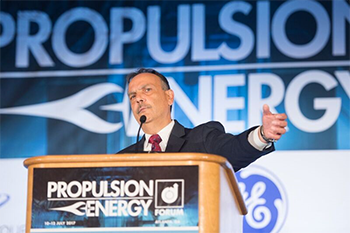Bending the Cost Curve Could Sustain Military Aviation’s Edge Written 10 July 2017
Speaker: Rafael A. Garcia, director, Propulsion Directorate, Air Force Materiel Command
By Lawrence Garrett, AIAA Web Editor

For the U.S. to sustain its long-standing level of excellence and its global edge in military aviation, propulsion costs must go down as readiness increases, said Rafael A. Garcia, director of Air Force Materiel Command’s Propulsion Directorate.
During the “Military Propulsion Needs” session July 10 at the 2017 AIAA Propulsion and Energy Forum in Atlanta, Garcia explained that downsizing in recent years has left the U.S. Air Force at its lowest personnel levels ever but that the service is still tasked with more missions.
“The U.S. Air Force has global commitments, every day, in every part of the world,” Garcia said. “Whether it’s flying refueling missions, whether it’s flying humanitarian missions, whether it’s supporting current theater of operations, we are a global force. We’re everywhere, every day, at all times.”
Garcia said the key to achieving the Propulsion Directorate’s mission of developing, acquiring, testing, fielding, sustaining and modernizing leading-edge aircraft engines for the Air Force and international partners is in life-cycle management, or the development of an initial concept from beginning to end.
However, he explained the Air Force can’t do it alone and that success is dependent upon key stakeholders and collaborators, including partners at the Air Force Research Laboratory and Air Force Sustainment Center and within industry.
“Industry brings to us a large level of innovation that at times we’re not able to tap into,” Garcia said. “We know that there’s a role in technology, that technology infusion that we can bring in that will leverage the process improvements we’ve made to continue to drive down our costs, to get the cost-effective readiness that we want to achieve.”
According to Garcia, only 2 percent of the Department of Defense’s current propulsion budget goes toward science and technology development. He said materiel serves as the largest sustainment cost driver, taking up 85 percent of the Air Force’s propulsion systems budget.
“It’s not labor; it’s not overhead; it’s materiel,” he said. “Technology can bend the cost curve.”
Garcia noted there are a number of existing areas of opportunity for private industry to collaborate with the Air Force, including the expansion of inspection capabilities through the introduction of new technologies such as the Advanced Topographical Optical Sensor, Dimensional Inspection and Visual Defect, all of which, he said, may lead to the possibility of eventually reusing previously unserviceable materiel.
“We see tremendous potential here,” Garcia said. “This has the potential to drive a lot of costs down for us. If I can get the inspection cost from $1,000 to $50, there’s many more things I can do with that money than I’m doing today.”
Garcia said that while the Air Force has done a pretty good job thus far at trying to identify some of those key areas in sustainment, he’s confident further collaboration with private industry can more rapidly bring about the needed new technologies.
